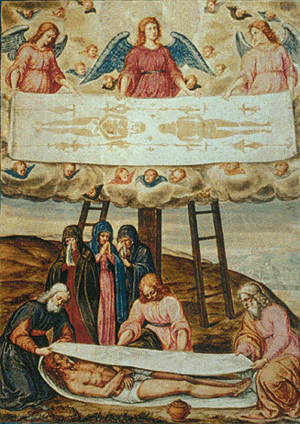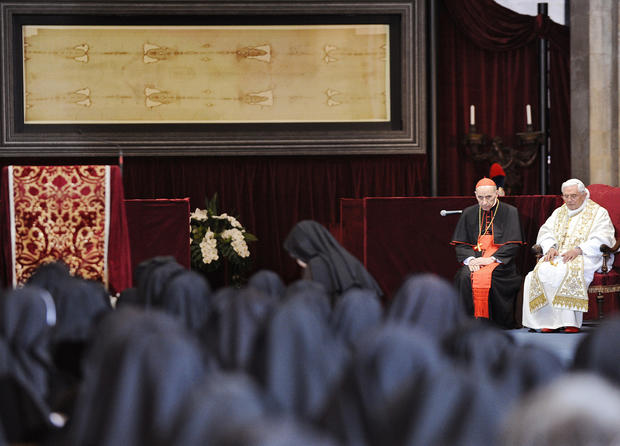Dear Friends: This is a moment to which I have been looking forward. I have stood before the Holy Shroud on various occasions but this time I am experiencing this Pilgrimage and this moment with special intensity: perhaps this is because the passing years make me even more sensitive to the message of this extraordinary Icon; perhaps and I would say above all this is because I am here now as the Successor of Peter, and I carry in my heart the whole Church, indeed, the whole of humanity.
One could say that the Shroud is the Icon of this mystery, the Icon of Holy Saturday. Indeed it is a winding-sheet that was wrapped around the body of a man who was crucified, corresponding in every way to what the Gospels tell us of Jesus.
Holy Saturday is the day when God remains hidden, we read in an ancient homily: “What has happened? Today the earth is shrouded in deep silence, deep silence and stillness, profound silence because the King sleeps. . . .God has died in the flesh, and has gone down to rouse the realm of the dead.” (Ancient Homily on Holy Saturday, PG 43, 439).
In the Creed, we profess that Jesus Christ was “crucified under Pontius Pilate, died, and was buried. He descended to the dead. On the third day, He rose again.”
Dear Brothers and Sisters, in our time, especially after having lived through the past century, humanity has become particularly sensitive to the mystery of Holy Saturday. The concealment of God is part of contemporary man’s spirituality, in an existential almost subconscious manner, like a void in the heart that has continued to grow larger and larger.
Toward the end of the 19th century, Nietzsche wrote: “God is dead! And we killed him!” This famous saying is clearly taken almost literally from the Christian tradition. We often repeat it in the Way of the Cross, perhaps without being fully aware of what we are saying.
After the two World Wars, the lagers and the gulags, Hiroshima and Nagasaki, our epoch has become increasingly a Holy Saturday: this day’s darkness challenges all who are wondering about life and it challenges us believers in particular. We too have something to do with this darkness.
Yet the Death of the Son of God, Jesus of Nazareth, has an opposite aspect, totally positive, a source of comfort and hope. And this reminds me of the fact that the Holy Shroud acts as a “photographic” document, with both a “positive” and a “negative.” And, in fact, this is really how it is: the darkest mystery of faith is at the same time the most luminous sign of a never-ending hope.
Holy Saturday is a “no man’s land” between the Death and the Resurrection, but this “no man’s land” was entered by One, the Only One, who passed through it with the signs of His Passion for man’s sake: Passio Christi. Passio hominis. [“Passion of Christ. Passion of man.”]
And the Shroud speaks to us precisely about this moment testifying exactly to that unique and unrepeatable interval in the history of humanity and the universe in which God, in Jesus Christ, not only shared our dying but also our remaining in death with the most radical solidarity.

In this “time-beyond-time,” Jesus Christ “descended to the dead.” What do these words mean? They mean that God, having made Himself man, reached the point of entering man’s most extreme and absolute solitude, where not a ray of love enters, where total abandonment reigns without any word of comfort: “hell.”
Jesus Christ, by remaining in death, passed beyond the door of this ultimate solitude to lead us too to cross it with Him. We have all, at some point, felt the frightening sensation of abandonment, and that is what we fear most about death, just as when we were children we were afraid to be alone in the dark and could only be reassured by the presence of a person who loved us.
Well, this is exactly what happened on Holy Saturday: the voice of God resounded in the realm of death. The unimaginable occurred: namely, Love penetrated “hell.” Even in the extreme darkness of the most absolute human loneliness we may hear a voice that calls us and find a hand that takes ours and leads us out.
Human beings live because they are loved and can love; and if love even penetrated the realm of death, then life also even reached there. In the hour of supreme solitude we shall never be alone: Passio Christi. Passio hominis.
This is the mystery of Holy Saturday! Truly from there, from the darkness of the Death of the Son of God, the light of a new hope gleamed: the light of the Resurrection. And it seems to me that, looking at this sacred Cloth through the eyes of faith, one may perceive something of this light.
Effectively, the Shroud was immersed in that profound darkness that was at the same time luminous; and I think that if thousands and thousands of people come to venerate it, without counting those who contemplate it through images, it is because they see in it not only darkness but also the light; not so much the defeat of life and of love, but rather victory, the victory of life over death, of love over hatred.
They Indeed see the death of Jesus, but they also see His Resurrection; in the bosom of death, life is now vibrant, since love dwells within it. This is the power of the Shroud: from the face of this “Man of Sorrows,” who carries with Him the passion of man of every time and every place, our passions too, our sufferings, our difficulties and our sins from this face a solemn majesty shines, a paradoxical lordship.
This face, these hands and these feet, this side, this whole body speaks. It is itself a word we can hear in the silence. How does the Shroud speak? It speaks with blood, and blood is life! The Shroud is an Icon written in blood; the blood of a man who was scourged, crowned with thorns, crucified, and whose right side was pierced.
The Image impressed upon the Shroud is that of a dead man, but the blood speaks of His life. . . .That blood and that water speak of life. It is like a spring that murmurs in the silence, and we can hear it, we can listen to it in the silence of Holy Saturday.
Dear friends, let us always praise the Lord for His faithful and merciful love. When we leave this holy place, may we carry in our eyes the image of the Shroud, may we carry in our hearts this word of love and praise God with a life full of faith, hope, and charity. Thank you.
*Image above: Descent from the Cross with the Shroud of Turin by Giulio Clovio (born Juraj Julije Klović), c. 1550-60 [Galleria Sabauda, Turin, Italy]















